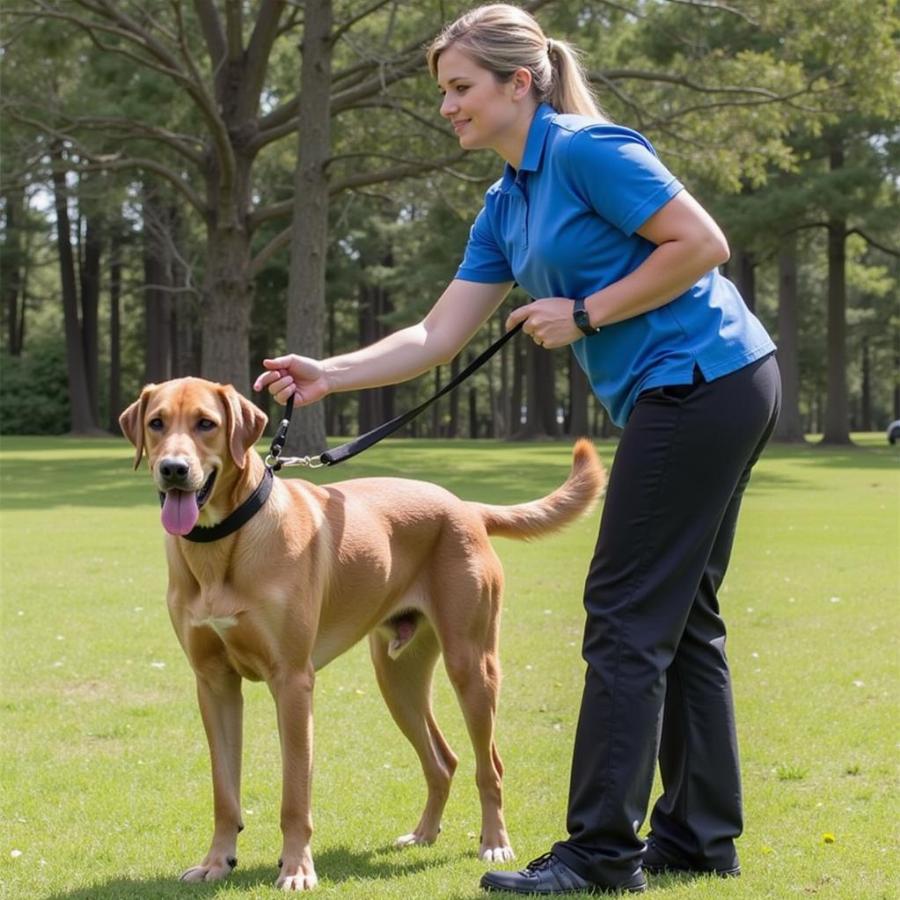Dog neck protection is a crucial aspect of responsible dog ownership, encompassing everything from everyday collars to specialized gear for specific activities. Ensuring your furry friend’s comfort and safety starts with understanding their needs and choosing the right equipment. This guide dives deep into the world of dog neck protection, providing valuable insights to help you make informed decisions for your beloved companion.
Choosing the Right Collar: A Foundation for Dog Neck Protection
The collar is the most basic form of dog neck protection and serves as an attachment point for identification tags and leashes. Selecting the right collar depends on your dog’s breed, size, activity level, and training needs. Flat collars are suitable for most dogs, while martingale collars are ideal for dogs prone to slipping out of their collars. For training, a slip collar can be helpful, but should be used under the guidance of a professional trainer. Never use a choke chain, as they can cause serious injury. Consider materials like nylon, leather, or even bio-degradable options.
Material Matters: Durability and Comfort for Your Dog
Choosing the right material is essential for both comfort and durability. Leather collars are classic and stylish, offering a timeless look. Nylon collars are known for their durability and water resistance, making them perfect for active dogs. Biothane collars are a great eco-friendly alternative. Always ensure the collar fits properly and isn’t too tight or too loose.
Beyond the Basics: Specialized Dog Neck Protection Gear
For certain activities or situations, specialized neck protection is necessary. Recovery collars, often called “cones of shame,” prevent dogs from licking or biting injuries. While they might seem cumbersome, they are crucial for proper healing. For working dogs or those participating in specific sports, protective neckwear might be required. Hunting dogs, for instance, may benefit from collars designed to protect against thorns and underbrush.
When to Consider Specialized Gear
Is your dog recovering from surgery or prone to excessive licking? A recovery collar is a must-have. Are you planning on taking your dog hiking or hunting in dense terrain? Consider protective neckwear. Remember, your dog’s safety and well-being should always be the top priority.
Dog Neck Protection and Training: A Balanced Approach
 Huấn Luyện Chó An Toàn
Huấn Luyện Chó An Toàn
Proper training plays a vital role in dog neck protection. A well-trained dog is less likely to pull on the leash, reducing strain on their neck. xxs dog clothes Using the right training tools, like a slip lead or martingale collar, can assist in teaching leash manners. However, these tools should only be used under the guidance of a qualified dog trainer. Avoid harsh corrections or using aversive training methods. Positive reinforcement techniques are more effective and humane.
Training Tips for Leash Manners and Neck Safety
Start training early, and be patient and consistent. Reward good behavior with treats and praise. Use a harness for dogs who pull excessively. Always supervise your dog while they are wearing any type of neck protection.
Conclusion: Prioritizing Your Dog’s Neck Health and Safety
Dog neck protection is more than just a collar; it’s about making informed choices that prioritize your dog’s comfort, safety, and well-being. From choosing the right collar to understanding specialized gear and training techniques, this guide provides the essential knowledge you need to ensure your canine companion enjoys a happy and healthy life. Remember to regularly check your dog’s collar for wear and tear, and consult with a veterinarian or professional dog trainer if you have any questions or concerns about dog neck protection.
FAQ: Common Questions about Dog Neck Protection
- What type of collar is best for a puppy? A lightweight, adjustable nylon or leather collar is ideal for puppies.
- How do I know if my dog’s collar fits properly? You should be able to fit two fingers comfortably between the collar and your dog’s neck.
- Are harnesses a good alternative to collars? Harnesses can be a great option, especially for dogs who pull on the leash.
- How often should I replace my dog’s collar? Replace the collar as soon as you notice signs of wear and tear, or if it no longer fits properly.
- What should I do if my dog’s collar gets wet? Allow it to air dry completely before putting it back on your dog.
Beaut Dogs is your trusted source for all things dog-related. We offer a wealth of information on dog breeds, care, and much more. Visit us at Beaut Dogs today! For further assistance, please contact us via Email: [email protected] and Beaut Dogs will gladly provide detailed and accurate answers.